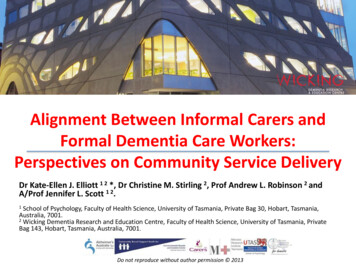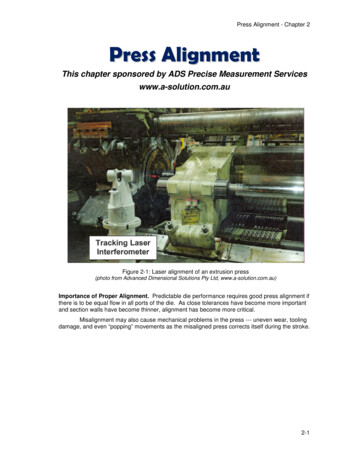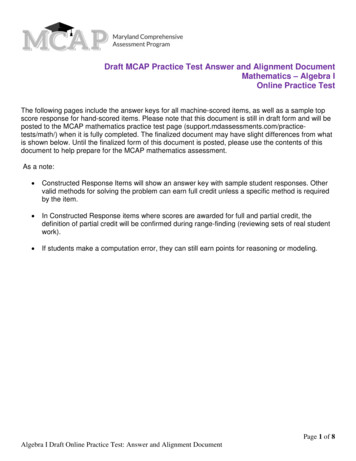
Transcription
Alignment Between Informal Carers andFormal Dementia Care Workers:Perspectives on Community Service DeliveryDr Kate-Ellen J. Elliott 1 2 *, Dr Christine M. Stirling 2, Prof Andrew L. Robinson 2 andA/Prof Jennifer L. Scott 1 2.1School of Psychology, Faculty of Health Science, University of Tasmania, Private Bag 30, Hobart, Tasmania,Australia, 7001.2 Wicking Dementia Research and Education Centre, Faculty of Health Science, University of Tasmania, PrivateBag 143, Hobart, Tasmania, Australia, 7001.Do not reproduce without author permission 2013
Dementia is a public health priority In 2010, 35.6 million people had dementia worldwide One new case every four seconds & will treble by 2050 In 2011, 298,000 Australians had dementia 62% were women, 74% were aged 75 and over, 70% livedin the community aged 65 , almost 1 in 10 (9%) had dementia, aged 85 , 3in 10 (30%) had dementia. 23,900 Australians under the age of 65 with dementia in2011(Access Economic, 2009; ABS, 2012; AIHW, 2007; Birch & Draper, 2008; Ferri et al, 2005; USAA, 2012;Wimo et al, 2003)Dr K Elliott 20132
Carers of people with dementia Most care for people with dementia is provided by familymembers or informal support systems in the community In Australia, estimates show that it would cost more than 30.5 billion per year to replace all informal dementia carers Enormous public health value of informal care can come atgreat cost to the carer (e.g., poor mental health) Projected shortage of more than 153,000 paid and unpaidcarers for people with dementia by 2029(Access Economics, 2005;2009; Cuijpers, 2005; Wimo & Prince, 2010; Zarit & Femia, 2008)Dr K Elliott 20133
Carers of people with dementia Important source of the evaluation of the health andaged care system Valuable resource for ideas and suggestions onfuture care packages and services Most research is focused on residential notcommunity care service delivery Even less on whether informal carers and paid formalcarers perspectives align(Lee et al., 2009; Litherland, 2008)Dr K Elliott 20134
Aim to assess the alignment of care expectationsfor informal and formal carers of people withdementia living in the communityDr K Elliott 20135
Methods Qualitative data was collected and analysedindependently for community-based; Informal dementia carers Workshop Formal dementia care workers Semi-structured interviews Data transcribed and coded for themes Very good inter-coder reliabilityDr K Elliott 20136
Brief demographics comparedN 61 (36 Informal carers; 25 formal care workers)Dr K Elliott 20137
Similar practical caring roles & unmet needs More information about dementia in community awareness make roles easier Isolated Informal carers felt “tied to the house” Formal carers felt “working alone is a downside” Wanted more time to spend caring Not just on practical tasks Also to promote social support and interactionDr K Elliott 20138
Coping with care roles Informal carers Counselling and psychological assessment and treatment Formal care workers Need for reflective work practices (e.g., regular meetingswith co-workers to discuss clients care needs and“debrief”) Both carer types Want better access to financial assistance and resources(e.g., electronic lift chairs)Dr K Elliott 20139
Positive care relationship Informal carers on workers “appreciative of workers”“need acknowledgement of their good work”“use kind speech”“listen and act” Formal care workers on people with dementia and theircarers Personal need for interaction with others Important skills included “listening”, “being respectful and empathic” Both carer types Views on each other were generally positive, minority some concerns Good relationship meant good careDr K Elliott 201310
Challenges for the care relationship Informal carers “workers are good once they are established” “workers need to care more” “lack understanding about disability” Formal care workers “conflict with carers and family members” “unrealistic demands” of clients and “unsupportive and critical families” Both carer types Starting a relationship with a person with dementiaDr K Elliott 201311
Workforce Informal carers staff shortages can influence the continuity of care for the person withdementia low numbers of specialised health professionals in their area, workers need training and knowledge of dementia Formal carer workers more specialised training higher levels of qualifications to be held by workers in dementia care in thefuture. changes in the clients they care for can be difficult to manage, particularly inlight of the loss of relationship and trust that was established over time recognised that worker knowledge of dementia helps the caring role Both carer types Worker continuity a concernDr K Elliott 201312
Community-based services Informal carers operate under a “case management approach”, as “enhanced communication within services”, and “more flexibility” for individuals needs were required “companionship” for care recipients a need Formal carer workers more services were needed to focus on the social participation of people withdementia importance of making time to “have a cup of tea” to provide social interaction Both carer types Community excursions and more social activities designed for people withdementia were desired by carers. improvements in funding would assist problems of access to resources forpeople with dementia and their carersDr K Elliott 201313
Quotes“I would like to have more support ‘cos I am tied to thehouse. The two support workers are pleasant andhelpful, but we want more skills and qualified workers”A comment made by a female informal carer.“There will be more clients and I think probably therehas to be more information for us on how to handlethe situation and more education for us. Like training,for example”A comment made by a female formal care worker.Dr K Elliott 201314
Strong alignment between carers more information about the services available better community understanding about dementianeeded specialised training for workers was commonlyreported a desire to improve the consistency of care more flexible services Limitations – data collected using different methodsDr K Elliott 201315
Conclusion Carers want improvements in access to information and support, workforce training and service delivery in the community setting. A broad approach should be applied to capacitybuilding for community-based dementia care. May include strategies that improve community dementiaawareness, workforce skills and organisational systems toreform future services.Dr K Elliott 201316
References1.2.3.4.ABS. (2012 ). 3303.0 - Cause of Death, Australia, 2010. Canberra: Australian Bureau of Statistics.AE. (2009). Making Choices: Future Dementia Care; Projections, Problems and Preferences: Access Economics for Alzheimer's Australia.AE. (2005). The Economic Value of Informal Care, Report for Carers Australia by Access Economics: Carers Australia.AIHW. (2007). Dementia in Australia: National Data Analysis and Development: Cat. No. AGE 53. Canberra: Australian Institute of Healthand Welfare.5. Birch, D., & Draper, J. (2008). A critical literature review exploring the challenges of delivering effective palliative care to older peoplewith dementia. Journal of Clinical Nursing, 17(9), 1144-1163. doi: 10.1111/j.1365-2702.2007.02220.x6. Cuijpers, P. (2005). Depressive disorders in caregivers of dementia patients: A systematic review. Ageing and Mental Health, 9(4), 325330. doi:10.1080/136078605000900787. Ferri, C., Prince, M., Brayne, C., Brodaty, H., Fratiglioni, L., Ganguli, M., . . . Scazufca, M. (2005). Global prevalence of dementia: A Delphiconsensus study. Lancet 336, 2112-2117.8. Lee, I., Wang, H.-H., Chiou, C.-J. and Chang, S.-H. (2009). Family caregivers’ viewpoints towards quality of long-term care services forcommunity-dwelling elders in Taiwan. Health & Social Care in the Community, 17, 312-320.9. Litherland, R. (2008). Involving people with dementia in service development and evaluation. In M. Downs and B. Bowers (Eds.)Excellence in Dementia: Research into Practice (pp. 397-413) London: Open University Press.10. Smith, J. A., Flowers, P. and Larkin, M. (2009). Interpretive Phenomenological Analysis: Theory, Method, and Practice. Thousand Oaks,CA: Sage.11. USAA. (2009). 2009 Alzheimer's Disease Facts and Figures. Alzheimer’s and Dementia: The Journal of the Alzheimer's Association, 5(3),234-270. doi:10.1016/j.jalz.2009.03.00112. WHO, & ADI. (2012). Dementia: A Public Health Priority. Geneva: World Health Organisation and Alzheimer's Disease International.13. Wimo, A., Winblad, B., Aguero-Torres, H., & von Strauss, E. (2003). The magnitude of dementia occurrence in the world. AlzheimerDisease and Associated Disorders, 17(2), 63-67.14. Zarit, S. H., & Femia, E. E. (2008). A future for family care and dementia intervention research? Challenges and strategies. Ageing andMental Health, 12(1), 5-13. doi: 10.1080/13607860701616317Dr K Elliott 201317
Alignment Between Informal Carers and Formal Dementia Care Workers: Perspectives on Community Service Delivery Dr Kate-Ellen J. Elliott 1 2 *, Dr Christine M. Stirling 2, Prof Andrew L. Robinson 2 and A/Prof Jennifer L. Scott 1 2. 1 School of Psychology, Faculty of Health Science, University of Tasmania, Private Bag 30, Hobart, Tasmania, Australia, 7001.










